Physical Address
304 North Cardinal St.
Dorchester Center, MA 02124
Success in lower extremity reconstruction is dependent on a comprehensive understanding of structural and functional anatomy. An anatomic- and defect-specific approach to lower extremity reconstruction enables the surgeon to provide tailored solutions for both the preservation and restoration of a functional limb.
A comprehensive appreciation for normal lower extremity anatomy and anatomical variants is critical to functional limb salvage when treating lower extremity pathology.
The reconstructive surgeon may be also be called upon to harvest tissue for transfer from the many potential donor sites in the lower extremity.
This chapter aims to provide a comprehensive review of the three-dimensional anatomy of the lower extremity to facilitate operative and clinical decision-making.
A detailed description is given of each region of the lower extremity with respect to skeletal support, musculofascial anatomy, vascularity, lymphatic drainage, peripheral nerves, and skin and soft-tissue elements.
A broad overview of available soft-tissue donor sites from each region, donor sites for bone grafts, anatomic basis of common lower extremity flaps, surgical approaches to lower extremity recipient vessels, and common points of nerve injury and entrapment are included to provide a clinically relevant discussion for anatomy of the lower extremity as a framework for common challenges in reconstructive surgery.
The pelvis consists of the two paired hip bones and the midline sacrum, articulating together at the two sacroiliac joints. The hip bones are formed by the fusion of the ilium, pubis, and ischium. These three bony regions of the pelvis coalesce to form the acetabulum. The large thick bony prominences of the pelvis serve as attachments for the muscles of the hip and thigh ( Fig. 1.1 ). These prominences also become clinically relevant in contributing to the formation of pressure ulcers, most commonly over the ischial tuberosity, sacrum, and greater trochanter. Dense ligaments stabilize and distribute the numerous opposing forces acting on the pelvis. The sacrospinous ligament runs from the sacrum to the ischial spine, bounding the greater sciatic foramen. The sacrotuberous ligament attaches the sacrum to the ischial tuberosity and encloses the lesser sciatic foramen. Running from the anterior superior iliac spine (ASIS) to the pubic tubercle is the inguinal ligament. The action of the multiple flexors, extensors, and internal and external rotators on the hip joint serves to stabilize and position the torso during the complex process of ambulation.
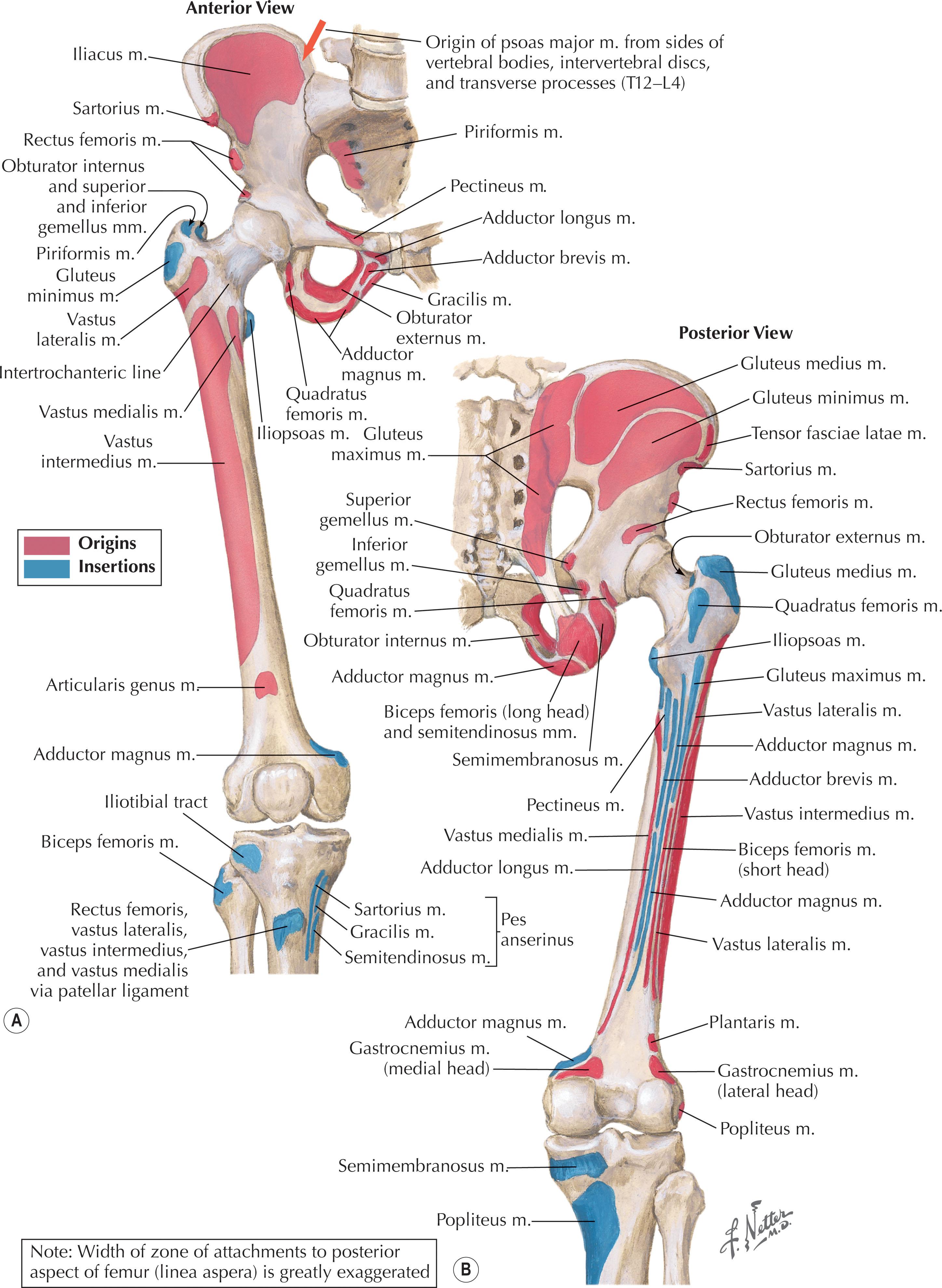
The iliac crest serves as a versatile source of autogenous bone graft to reconstruct a variety of defects. Bone grafts can be cortical, cancellous, or corticocancellous in composition. Cortical bone is structurally stable with osteoconductive properties and ideally suited for structural defects requiring immediate mechanical stability. Cancellous bone is osteoinductive, osteogenic, and osteoconductive, undergoes rapid remodeling and vascularization, and is ideally suited for non-unions and bony fusion. Cancellous bone can be obtained between the inner and outer table of the ilium. The anterior and posterior iliac crest are common donor sites for cancellous and corticocancellous bone grafts, with 13 cm 3 and 30 cm 3 average graft volumes available from the anterior and posterior crest, respectively ( Fig. 1.2 ). Anteriorly, bone graft is most commonly harvested from the iliac tubercle, 3–4 cm posterior and parallel to the ASIS to maximize available bone and minimize risk to the lateral femoral cutaneous nerve. The iliac crest lies deep to a musculofascial layer from the external oblique and the iliacus muscle. The ilioinguinal nerve runs along the medial surface of the iliacus muscle and is at risk during harvest from the anterior crest. The anterior iliac crest provides twice the volume of packed cancellous bone compared to the distal radius or olecranon. Alternatively, tricortical bone grafts can be harvested from the inner and outer table of the anterior ilium and corticocancellous bone grafts can be harvested to include either the inner or outer table. Posteriorly, the bone is thickest and best harvested in the area superior to a line connecting the posterior superior iliac spine (PSIS) and the apex of the sacroiliac joint. Harvesting from an area approximately 4 cm distal to the PSIS prevents violation of the sacroiliac joint. Unicortical and corticocancellous bone grafts can be obtained from the outer table of the posterior ilium and additional cancellous bone harvested from the inner table of the ilium. The iliac crest can also provide vascularized bone for a variety of composite soft-tissue and bone defects. Corticocancellous, vascularized bone can be obtained from the outer cortex of the ilium on the lateral half of the iliac crest, supplied by the ascending branch of the lateral femoral circumflex system. The inner cortex of the ilium, supplied through nutrient branches off the deep circumflex iliac artery, is another common source of vascularized iliac bone.
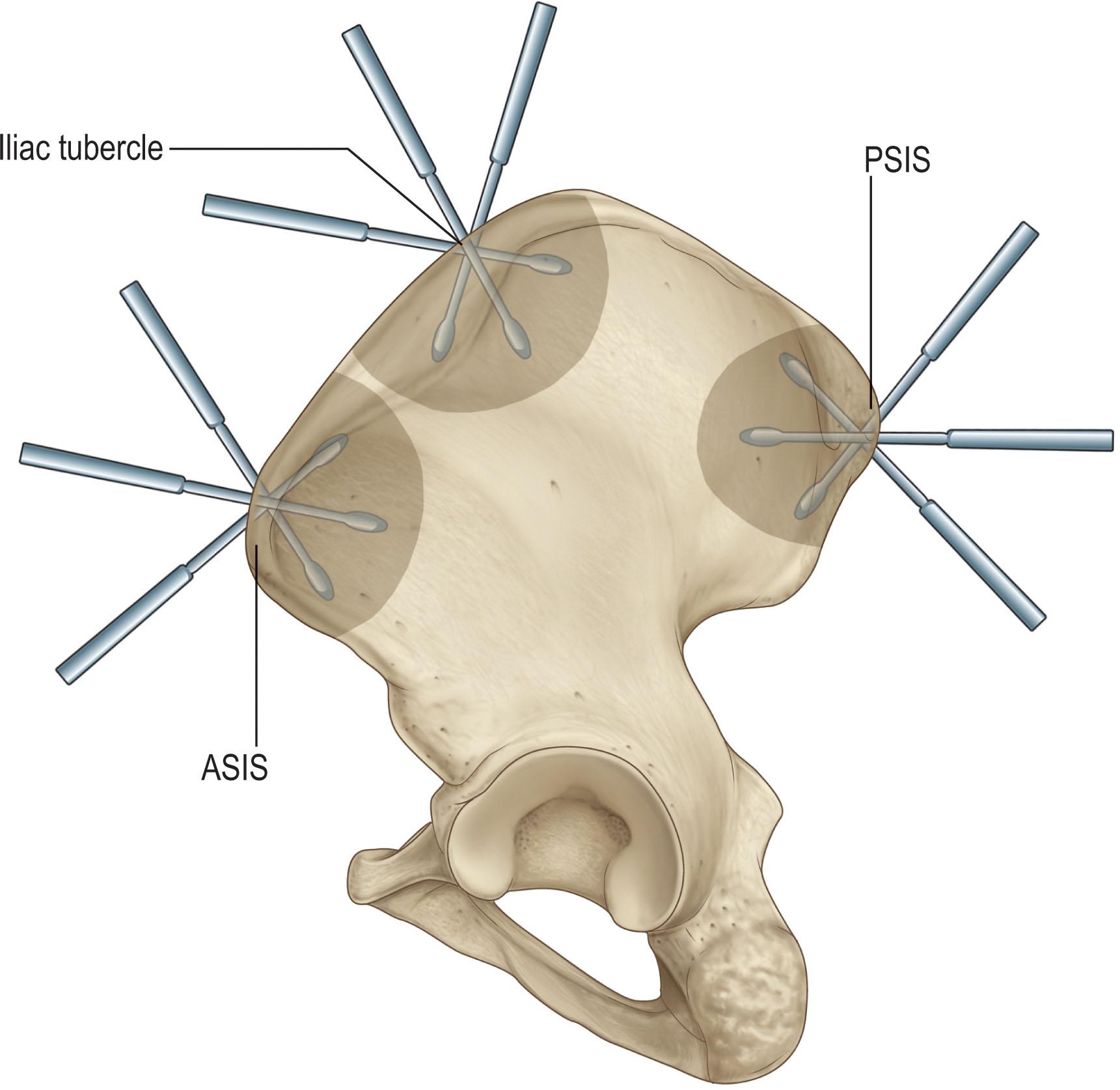
The fascial system of the gluteal region and the lower extremity contains various permutations of a nearly continuous superficial fascial and a deep fascial layer. The superficial system is located in the subcutaneous fat. The deep fascial layer is thicker and frequently can be seen as a dual-layered fibrous band. It usually lies directly over the underlying limb musculature and its proper fascia. The superficial fascia of the gluteal region is contiguous with that over the lower back and continues inferiorly into the proximal thigh. The deep fascia covering the gluteal muscles varies in thickness. Over the maximus it is thin, but over the anterior two-thirds of the medius it thickens and forms the gluteal aponeurosis. This is attached to the lateral border of the iliac crest superiorly, and splits anteriorly to enclose the tensor fasciae latae and posteriorly to enclose the gluteus maximus.
The gluteus maximus is the largest muscle in the body and lies most superficially in the gluteal region, originating from the posterior gluteal line of the ilium and the dorsal portion of the sacrum ( Fig. 1.3 ). The superficial fibers coalesce into a thick tendinous expansion which contributes to the iliotibial band of the fascia lata, while the deep fibers insert on the gluteal tuberosity of the femur. The gluteus maximus acts as a hip extensor when the hip is in a flexed position. In a standing position, the gluteus maximus dorsally rotates the pelvis and torso, maintaining stability. The vascular supply is primarily derived from the inferior gluteal vessels, which supply the inferior two-thirds of the muscle. The superior gluteal vessels supply the superior portion and the first perforator branch of the profunda femoris contributes to the vascular supply of the muscle laterally. For ease of description, the Mathes–Nahai classification system is used when discussing muscle vascularity ( Table 1.1 ). The gluteus maximus has a type III vascular supply, with two dominant pedicles from the superior and inferior gluteal arteries. Innervation to the gluteus maximus is provided by the inferior gluteal nerve. Underneath the gluteus maximus lie three bursae: the trochanteric, gluteofemoral, and ischiofemoral bursae, which allow frictionless movement over its underlying structures.
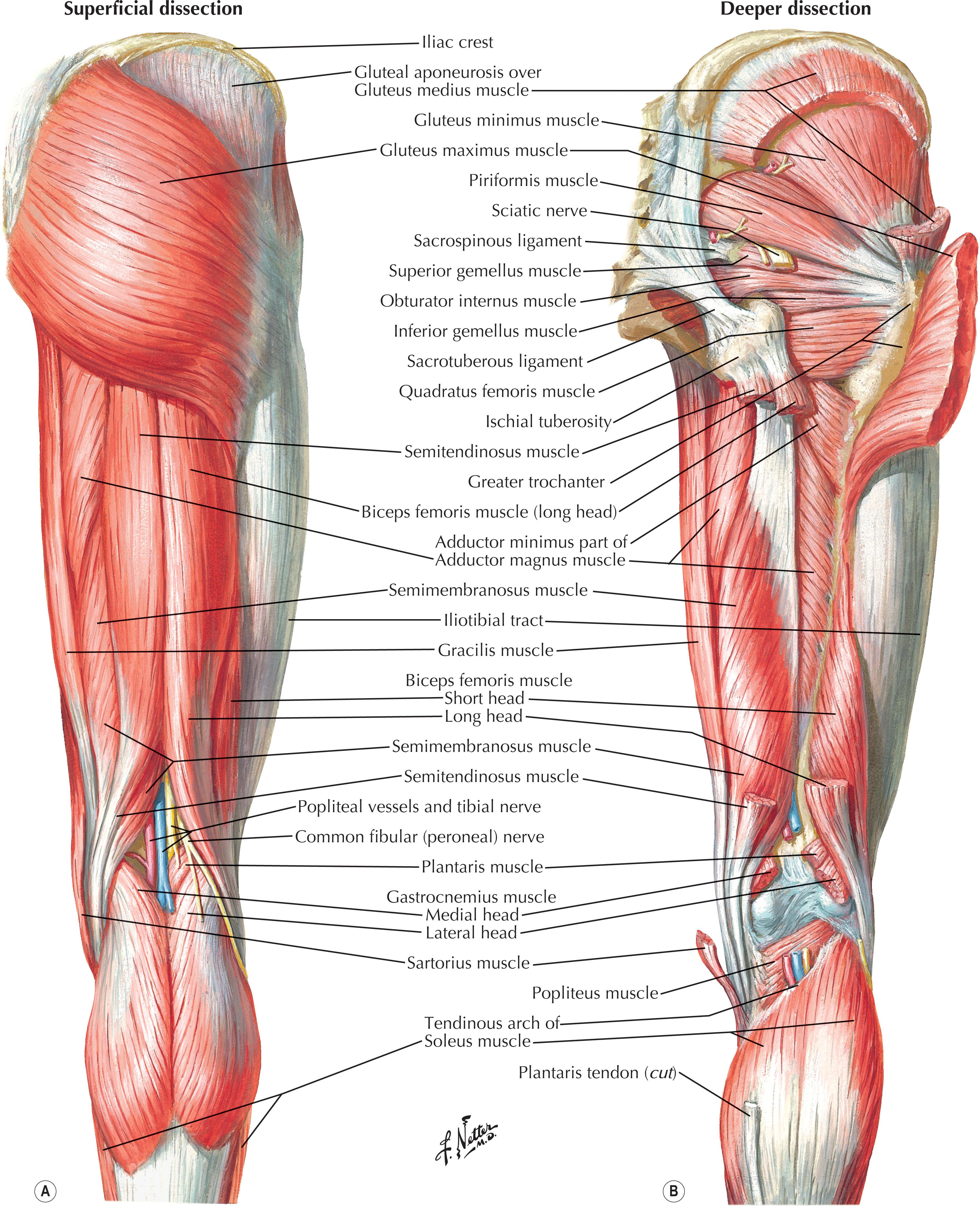
| Muscle vascular supply type | Description |
|---|---|
| I | Single vascular pedicle |
| II | Dominant vascular pedicle and one or more minor pedicles |
| III | Two dominant pedicles |
| IV | Segmental vascular pedicles |
| V | Single dominant vascular pedicle and secondary segmental pedicles |
The gluteus medius, situated immediately deep to the gluteus maximus, arises from the outer surface of the iliac wing and inserts on the greater trochanter of the femur. It is innervated by the superior gluteal nerve and functions to abduct the hip and medially rotate the femur. Blood supply to this muscle is from the deep branch of the superior gluteal artery and from the trochanteric connection.
The gluteus minimus lies deep to the gluteus medius and arises from the outer surface of the ilium. Its fibers join the aponeurosis of the gluteus medius to insert on the greater trochanter, and the two muscles function together to abduct the hip. The gluteus minimus is innervated by the superior gluteal nerve and receives blood supply from the superior gluteal artery and trochanteric connection. Several small muscles arise from the medial pelvis and insert on the greater trochanter of the femur, functioning collectively to rotate the hip externally. These muscles include piriformis, superior and inferior gemellus, quadratus femoris, obturator internus, and obturator externus.
The superior gluteal artery (SGA) is the last branch of the posterior trunk of the internal iliac artery. It exits the pelvis through the greater sciatic foramen superior to the piriformis, dividing into two branches ( Fig. 1.4 ). The deep branch runs deep to the gluteus medius, dividing into superior and inferior branches. The superior branch travels laterally to the anterior superior iliac spine and connects with the ascending branch of the lateral circumflex femoral and the deep circumflex iliac. The inferior branch supplies the gluteus medius and minimus, and later joins with the lateral circumflex femoral. The superficial branch of the superior gluteal artery pierces the gluteus maximus, connecting intramuscularly with branches of the inferior gluteal artery, and sending musculocutaneous perforators to the overlying skin. The inferior gluteal artery (IGA) branches from the anterior trunk of the internal iliac and exits the pelvis through the greater sciatic foramen below the piriformis. It runs deep to the gluteus maximus, supplying it and its overlying skin with musculocutaneous perforators. The descending branch of the inferior gluteal artery continues down the posterior thigh, between the semitendinosus and biceps femoris, running with the posterior cutaneous nerve and connecting with the perforating branches to supply the skin.

Perforating branches from the SGA and IGA can be used to perfuse free and pedicled flaps to reconstruct a variety of soft-tissue defects. There is considerable variability in size, location, and branching pattern of perforators in the gluteal region. Generally, the superior gluteal region is perfused by perforators from the SGA and the inferior gluteal region is perfused by perforators from the IGA. SGA perforators can be reliably found medial and adjacent to a line drawn from the PSIS to the greater trochanter and range in number from 5 to 11 perforators. The mean size of SGA perforators is 0.6 mm; however, there is always a perforator greater than 0.8 mm in diameter and, on average, at least 4 perforators per side greater than 0.8 mm. Perforator lengths for pedicle use vary from 4 cm to 10 cm and are dependent on the extent of dissection to the source vessel. The thickness and size of subcutaneous tissue that can be reliably perfused by SGA perforators follows the perforasome theory. Flaps harvested on the superficial fascial plane can be “ultra-thin”, with thickness ranging from 5 mm to 11 mm and an average flap size of 125 cm 2 . IGA perforators range in number from 4 to 12 perforators each side, with a mean diameter of 0.4 to 0.6 mm, and perforator lengths vary from 4 cm to 14 cm. Perforators from the IGA can perfuse an average of 175 cm 2 of subcutaneous tissue, with thickness ranging from 1 cm to 6 cm depending on indication and patient body habitus.
The SGA is also a valuable recipient vessel in the setting of complex posterior trunk, lumbosacral spine, and/or pelvic defects requiring free tissue transfer for reconstruction. There is a dearth of suitable recipient vessels for lower back and/or pelvic reconstruction. The superior gluteal artery and accompanying vein are reliable recipient vessels and have a predictable size, location, and length.
A follow-the-perforator approach is an efficient way to identify the underlying main SGA. By identifying the perforators on the skin with Doppler probe based on the aforementioned anatomical relationships, the surgeon can then dissect the perforator to the source SGA where the caliber is more suitable for microvascular anastomoses. Dissection through the fascia and proceeding deep in the plane between the piriformis and gluteus is necessary. There is often a moderate amount of intramuscular dissection required and it is critical to ligate branches off the SGA to facilitate exposure. At this level, the caliber is often 2–4 mm. We recommend dissection to obtain a length of at least 4–5 cm on the recipient SGA as this allows the vessel to be brought more superficial to avoid anastomosis in a deep hole. Selecting a donor flap with a longer pedicle and deep self-retaining retractors also decrease the technical difficulty of anastomosis to the SGA.
The posterior cutaneous nerve of the thigh exits the pelvis with the inferior gluteal vessels ( Fig. 1.4 ). Several branches will curl around the inferior border of the gluteus maximus and run superiorly to innervate the overlying skin of the buttocks, while the posterior cutaneous nerve continues to descend down the posterior thigh deep to the fascia lata, sending segmental cutaneous branches to the skin of the posterior thigh. The gluteal muscles are innervated by the superior and inferior gluteal nerves. The superior gluteal nerve runs with the superior gluteal artery and divides into superior and inferior branches, which course respectively with the superior and inferior branches of the deep superior gluteal artery, supplying the gluteus medius and minimus. The inferior branch runs laterally to also innervate the tensor fascia latae. The inferior gluteal nerve runs with the inferior gluteal artery, exiting the pelvis below the piriformis and entering the gluteus maximus.
The thigh region is generally defined as the cylindrical proximal portion of the lower extremity that extends from the infragluteal crease and the inguinal ligament distally to the tibiofemoral joint. The thigh aids in trunk support and positioning of the knee in space, serving a critical role in ambulation. The muscles of the thigh are some of the largest in the body and often have redundant or overlapping function. Similarly, the corresponding fasciocutaneous coverage in the thigh is relatively redundant. Thorough knowledge of thigh anatomy is key for taking advantage of these redundancies and utilizing the thigh as a generous source of donor tissue for local, regional, and distant reconstructive surgical options.
The femur is the longest bone in the body and the predominant bone in the thigh region. The femoral head articulates with the pelvic acetabulum to form the only true ball-and-socket joint in the body, allowing for stability under load as well as smooth multiplanar movement. Two bony prominences emanate from the femoral neck at about 90° from each other – the greater and lesser trochanters. These femoral prominences primarily serve as insertion sites for hip actors ( Fig. 1.1 ). The action of multiple flexors, extensors, and internal and external rotators on the hip joint serves to stabilize and position the torso during the complex process of ambulation.
The vascular supply of the femoral bone arises from multiple sources. The femoral head and neck are encircled by an arterial anastomosis between the medial and lateral circumflex arteries with lesser contribution by the superior and inferior gluteal vessels. The femoral shaft has multiple nutrient foramina supplied by branches from the second perforating artery from the profunda femoris. These foramina usually run along the linea aspera on the posterior surface of the femur in the middle one-third of the femoral shaft. Periosteal vascularity along the femur receives vascular input from either the perforating branches of the profunda or directly from the profunda femoris. The distal metaphyseal region of the femur also has multiple vascular foramina that are derived from the genicular arterial system.
The arterial anatomy of the distal femur, specifically the medial femoral condyle and supracondylar region, has clinical significance as it is the anatomical basis for the medial femoral condyle (MFC) vascularized corticoperiosteal flap ( Fig. 1.5 ). This flap can be harvested as a corticoperiosteal free or pedicled flap with or without cancellous bone and provides an excellent option for transfer of vascularized bone in the treatment of recalcitrant fracture nonunions. The vascular supply to the MFC is derived from the descending genicular artery (DGA) and/or the superior medial genicular artery. The DGA, the longer and larger of the two vessels, is a medial branch off the superficial femoral artery and originates just proximal to the adductor hiatus, approximately 14 cm proximal to the knee joint. The DGA is the dominant vessel to the medial femoral condyle 90% of the time, has a mean pedicle length of 8 cm, and has a proximal diameter of at least 1.5 mm, suitable for microsurgical anastomosis. The superior medial genicular artery, a branch off the popliteal artery, has a smaller vessel diameter of 0.8 mm and pedicle length of 5 cm, and therefore is less utilized when harvesting a flap. The osteoarticular branch of the DGA provides periosteal perfusion, and there are numerous intraosseous perforators to the MFC. Paired venae comitantes provide venous drainage for the MFC flap, often converging to form the short descending genicular vein.
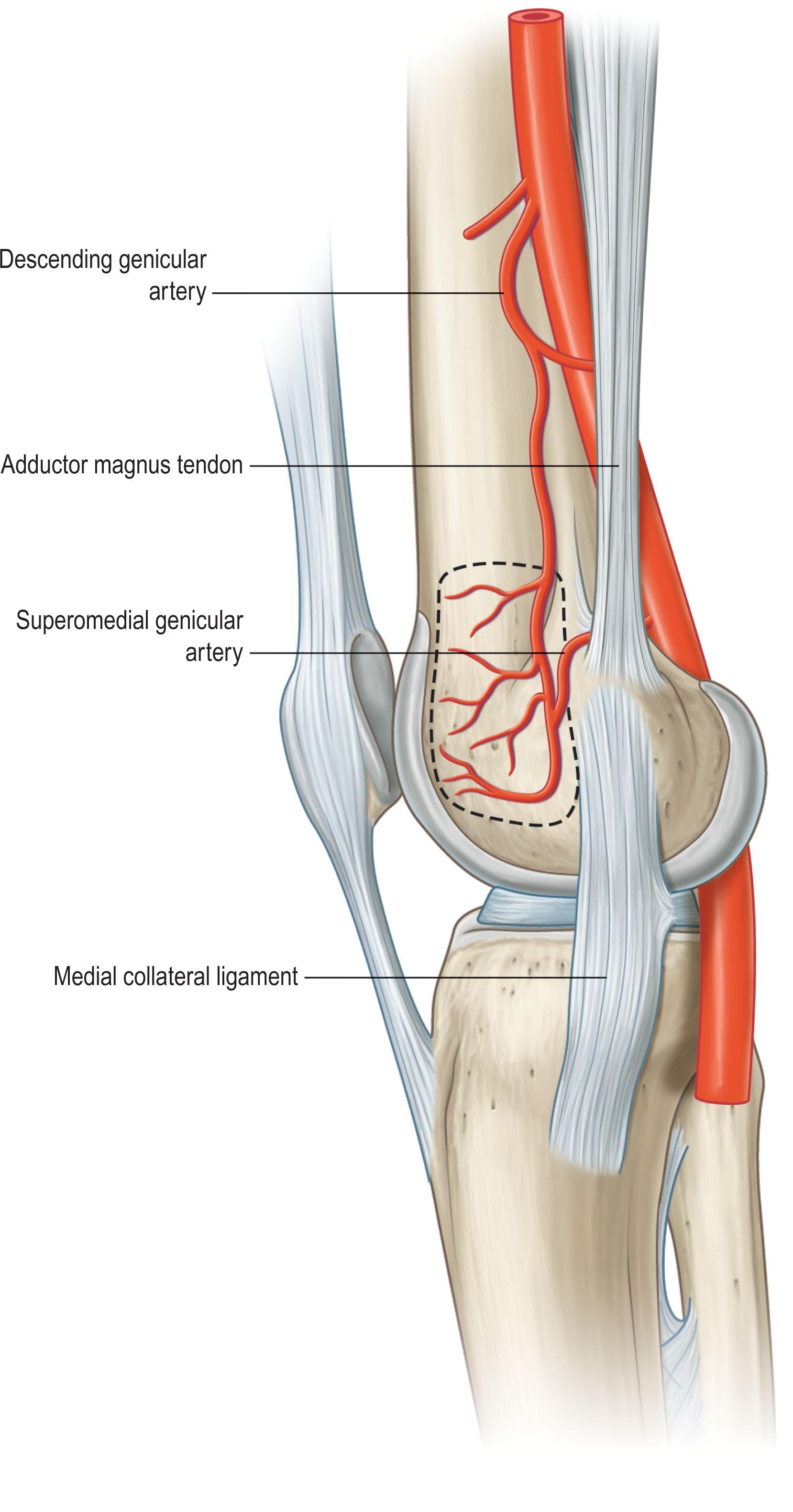
The thigh has a superficial and deep fascial system. The superficial fascia lies within the subcutaneous fat of the thigh encircling the entire structure. Superficial vessels and nerves pass along and pierce this fascia as they travel to the skin. The thickness of the fascia varies throughout the thigh but thickens proximally in the inguinal region. At the inguinal ligament the superficial fascia fuses with the deep thigh fascia.
The deep fascia is a tough, well-vascularized fibrous tissue that lies beneath the superficial fascia and the subcutaneous fat. This fibrous structure encircles and constrains the thigh musculature in a near-complete sheath. There is varying terminology used to describe the deep fascia of the thigh and this is often a source of confusion. The deep fascia of the thigh is also called investing fascia or the fascia lata. For simplicity and consistency, it will be referred to as the deep fascia in this text. The deep fascia of the thigh attaches posteriorly to the sacrum and coccyx, anteriorly to the inguinal ligament, and laterally to the iliac crest. At the inguinal ligament, where the superficial fascia joins the deep fascia, there is an opening in both fascial layers called the fossa ovalis. The great saphenous vein, superficial branches of the femoral artery, and lymphatics pass through this opening between the deep and the superficial layers of the thigh ( Fig. 1.6 ). This opening is covered by a membranous layer of the superficial fascia called the cribriform fascia. A thickening of the fibrous tissues is present on the lateral aspect of the deep fascia and is termed the iliotibial band or tract ( Fig. 1.7 ). The iliotibial band is proximally attached to the tensor fascia latae muscle and together this myofascial unit aids in maintaining knee extension.
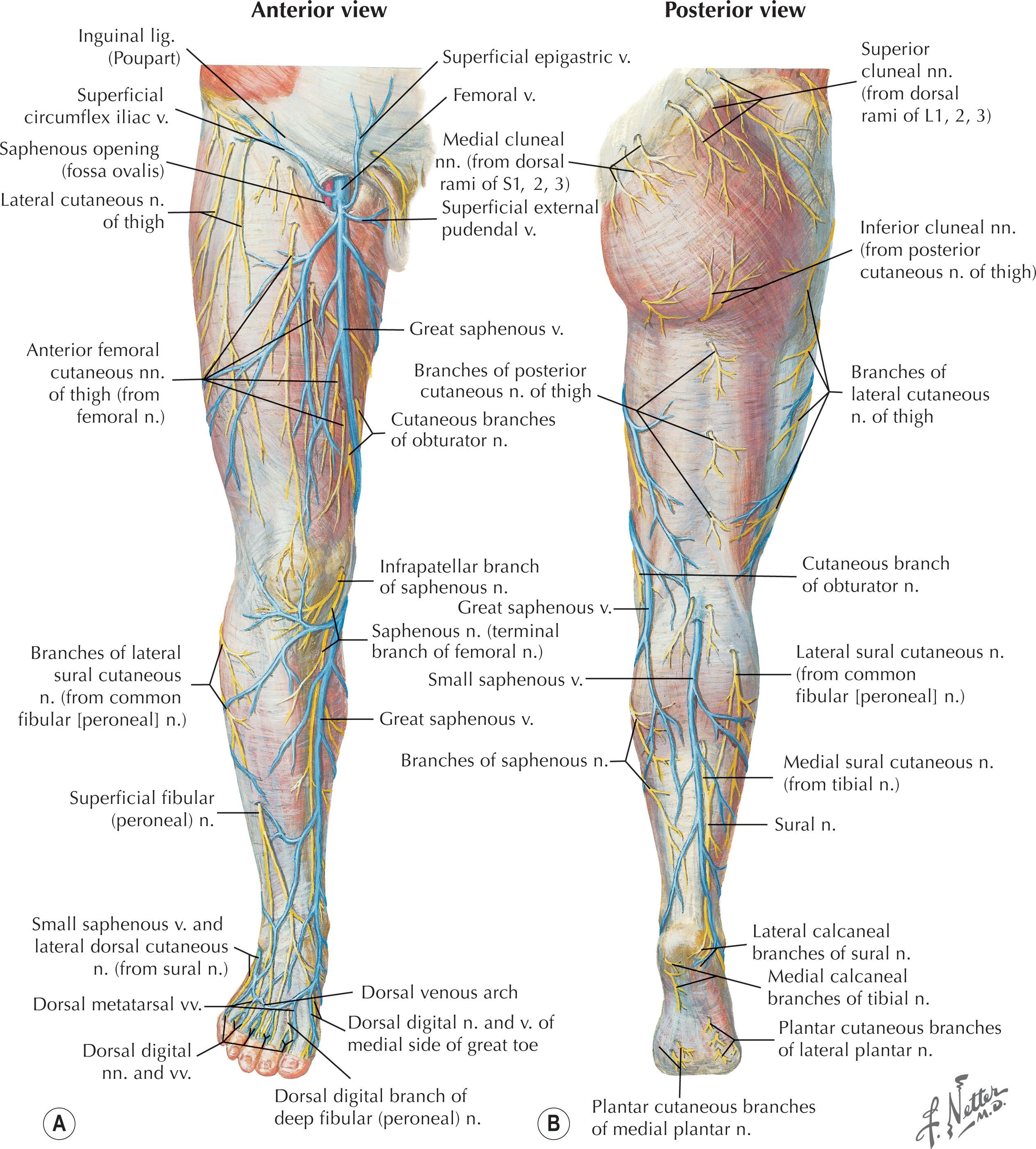
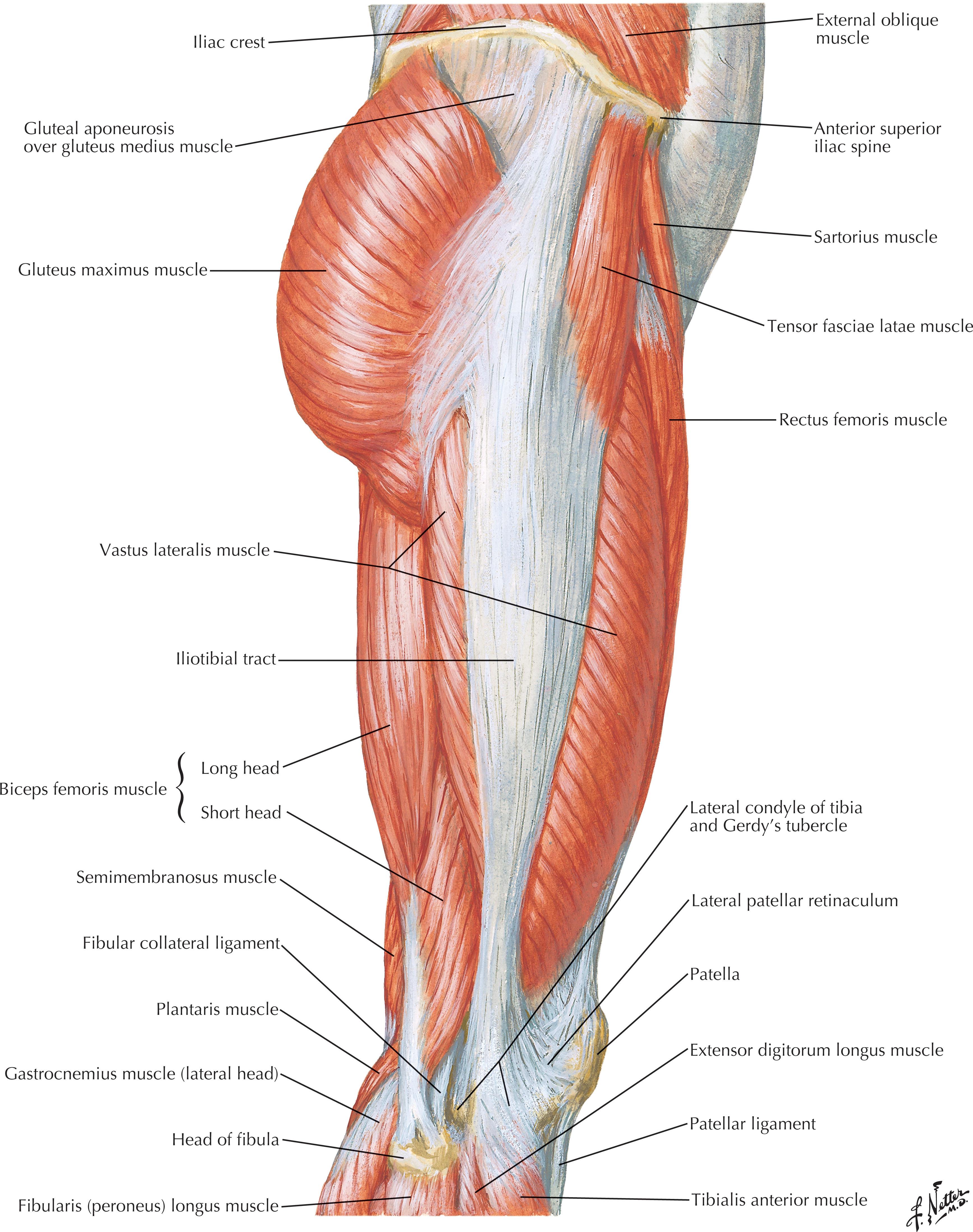
Septa pass from the deep fascial sheath to the bones underneath, confining the functional muscle groups within osteofascial compartments. In addition to separating musculature, fascial planes also provide pathways for vessel perforators to travel from deeper vasculature to the overlying skin. There are three functional compartments of the thigh: anterior, posterior, and medial. The anterior compartment contains the knee extensor muscles; the posterior compartment comprises knee flexors; and the medial compartment retains the hip adductors ( Fig. 1.8 ). The medial and lateral intermuscular septa travel from the fascia lata to attach to the femur on the linea aspera along its posterior aspect. These septa then divide the anterior compartment from the posterior compartments and partition the thigh musculature according to knee function. Only the anterior and posterior compartments have definite fascial boundaries. The medial (adductor) compartment is not a true anatomical compartment as it has no defined intermuscular septa separating it. The muscles of the adductor compartment – gracilis, pectineus, adductor longus, adductor brevis, and adductor magnus – form a functional compartment in the proximal aspect of the thigh.
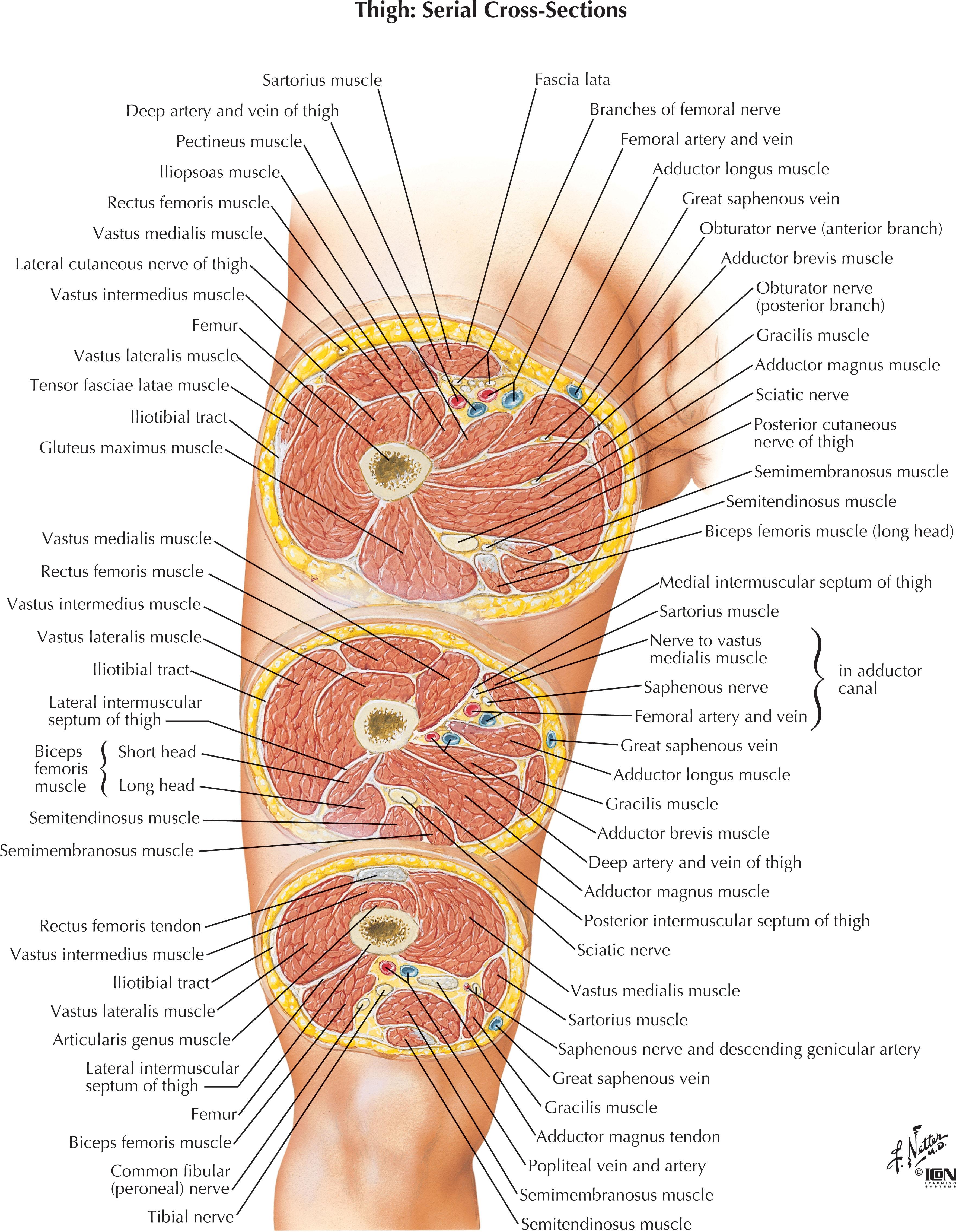
The three compartments of the thigh are a well-organized way to approach the thigh musculature ( Table 1.2 ). There are 17 muscles that course through the region of the thigh. The anterior thigh compartment contains the sartorius, articularis genu, and quadriceps femoris comprising the rectus femoris, vastus lateralis, intermedius, and medialis. These muscles are the primary knee extensors. All of the anterior compartment muscles share a single articular function, with the exception of the sartorius and the rectus femoris, which cross both the hip joint and the knee joint. The sartorius muscle is the most superficial muscle of the thigh. It obliquely crosses the anterior thigh from superolateral to medial inferior. The proximal end of the sartorius makes up one of the three limbs of the femoral triangle: the medial border of the sartorius makes up the lateral side, the medial border of the adductor longus makes up the medial side, and the inguinal ligament makes up the superior limb ( Fig. 1.9 ). The femoral triangle denotes the region where the femoral artery, nerve, and vein are transiently uncovered superficially by muscle in the proximal thigh. Here, all three structures radiate multiple branches in multiple directions to supply the vasculature and innervation to the groin region, lower abdomen, and proximal thigh. As the femoral artery, vein, and nerve descend distally in the thigh, they dive under the adductor longus and then proceed to the adductor canal. At the distal end of the sartorius, the muscle inserts on the proximal, medial surface of the tibia. The sartorius inserts in this region above the gracilis, which then inserts above the semitendinosus ( Fig. 1.10 ). This three-muscle insertion point forms the pes anserinus. The superficial location of the sartorius muscle and its proximity to the femoral triangle make it an ideal flap for muscle transposition coverage over proximal thigh wounds with vessel or prosthetic graft exposure. The vascular anatomy of the sartorius muscle is traditionally described as a type IV, segmental pattern. Six to eight muscular branches enter the sartorius along the length of the muscle from different source vessels. The proximal third is supplied by branches from the superficial circumflex iliac and the lateral circumflex femoral arteries. The middle third receives multiple branches from the superficial femoral artery. The distal third of the muscle is supplied by muscular branches of the descending genicular and superomedial genicular arteries ( Fig. 1.11 ). A recent anatomic study has challenged this purely segmental classification, demonstrating two dominant vascular pedicles. This renewed anatomical understanding of the sartorius muscle suggests that it may be based on a single pedicle, and therefore have a larger arc of rotation for wound coverage.
| Muscle | Origin | Insertion | Function | Blood supply | Flap blood supply type | Innervation | ||
|---|---|---|---|---|---|---|---|---|
| Hip-related | 1 | Iliacus | Pelvis – iliac fossa | Lesser trochanter of femur – inferior edge | Hip flexion and internal rotation | – | – | Femoral nerve – intra-abdominal |
| 2 | Psoas major | Thoracic and lumbar spine (T12–L5) | Lesser trochanter of femur – middle region | Hip flexion and internal rotation | – | – | Lumbar spinal nerves | |
| Anterior compartment | 3 | Sartorius | Anterior superior iliac spine (ASIS) | Medial, proximal tibia (pes anserinus) | Flexes, abducts, and external rotates thigh at hip; flexes, internally rotates leg at knee | Multiple branches for the superficial femoral artery | Segmental (type IV) | Femoral nerve (anterior division) |
| 4 | Rectus femoris | ASIS and ilium | Quadriceps tendon–patella tendon–tibial tuberosity | Hip flexion and knee extension | Descending branch of LCFA (dominant); ascending branch of LCFA (minor), muscular branch of superficial femoral artery (minor) | One dominant and minor pedicles (type II) | Femoral nerve (posterior division) | |
| 5 | Vastus lateralis | Shaft of femur – upper intertrochanteric line, base of greater trochanter, lateral linea aspera, lateral supracondylar ridge, and lateral intermuscular septum | Quadriceps tendon–patella tendon–tibial tuberosity (lateral aspect) | Knee extension | Descending branch of LCFA (dominant); transverse branch of LCFA (minor), posterior branches of profunda femoris (minor), branch of superior genicular artery (minor) | One dominant and minor pedicles (type II) | Femoral nerve (posterior division) | |
| 6 | Vastus medialis | Shaft of femur – lower intertrochanteric line, spiral line, medial linea aspera, and medial intermuscular septum | Quadriceps tendon–patella tendon–tibial tuberosity | Knee extension, patellar stabilization | Branch of superficial femoral artery (dominant); distal branches of the superficial femoral artery (minor), branches of descending genicular artery (minor) | One dominant and minor pedicles (type II) | Femoral nerve (posterior division) | |
| 7 | Vastus intermedialis | Shaft of femur – inferior one-third | Quadriceps tendon–patella tendon–tibial tuberosity | Knee extension | Lateral direct branch from the profunda femoris (dominant); medial direct branch from the profunda femoris (minor) | One dominant and minor pedicles (type II) | Femoral nerve (posterior division) | |
| 8 | Articularis genu | Femur – anterior, distal surface of shaft | Apex of suprapatellar bursa | Retracts bursa as knee extends | Direct branch of profunda femoris | – | Femoral nerve (posterior division) | |
| Posterior compartment | 9 | Biceps femoris | Long head: ischial tuberosity – posterior surface Short head: linea aspera – middle third and lateral supracondylar ridge of femur | Lateral condyle of tibia & head of fibula | Long head: extends knee Both heads: flexes and laterally rotates knee | Long head: first perforating branch of profunda femoris (dominant); inferior gluteal artery branch (minor), second perforating branch of profunda (minor); short head: second or third perforating branch of profunda (dominant); superior lateral genicular artery (minor) | One dominant and minor pedicles (type II) | Long head: tibial nerve Short head: common peroneal nerve |
| 10 | Semitendinosus | Ischial tuberosity – medial surface | Medial, proximal tibia (pes anserinus) – below gracilis insertion | Extends hip, flexes, and medially rotates the knee | First perforating branch of profunda femoris (dominant); inferior gluteal artery branch (minor), second or third perforating branch of profunda (minor), superficial femoral artery branch (minor) | One dominant and minor pedicles (type II) | Tibial nerve | |
| 11 | Semimembranosus | Ischial tuberosity – lateral surface | Medial condyle | Extends hip, flexes, and medially rotates the knee | First perforating branch of profunda femoris (dominant); muscular branch of inferior gluteal artery (minor), descending branch of MCFA, inferior medial genicular artery | One dominant and minor pedicles (type II) | Tibial nerve | |
| Adductor compartment | 12 | Adductor magnus | Pubic bone – ischiopubic ramus | Femoral shaft, inferior – lower gluteal line and linea aspera | Hip adduction, internal hip rotation | Branches from the obturator, profunda femoris, and superficial femoral arteries | – | Obturator nerve (posterior division) |
| 13 | Adductor longus | Pubic bone – pubic tubercle | Femur – inferior aspect of linea aspera | Hip adduction, internal hip rotation | Branch from profunda femoris (artery to the adductors); branches from MCFA, distal branch from the superficial femoral artery | – | Obturator nerve (anterior division) | |
| 14 | Adductor brevis | Pubic bone – superior and inferior ramus | Femur – superior aspect of linea aspera | Hip adduction | Variable – branch of profunda femoris versus branch from MCFA; obturator artery | – | Obturator nerve (anterior division) | |
| 15 | Gracilis | Pubic bone – ischiopubic ramus | Medial, proximal tibia (pes anserinus), below the sartorius | Hip adduction, knee flexion, and internal rotation | Ascending branch of MCFA (dominant); 1–2 branches from the superficial femoral artery | One dominant and minor pedicles (type II) | Obturator nerve (anterior division) | |
| 16 | Pectineus | Pubic bone | Proximal femur – below the lesser trochanter | Hip adduction, knee flexion, and internal rotation | Branches from the MCFA, common femoral, and obturator arteries | – | Femoral nerve (anterior division) | |
| Extra-compartmental | 17 | Tensor fascia latae | Iliac crest | Iliotibial tract–lateral tibia condyle (anterior surface) | Maintains knee extension (assists gluteus maximus) and hip abduction | Ascending branch of the LCFA | One dominant artery (type I) | Superior gluteal nerve |
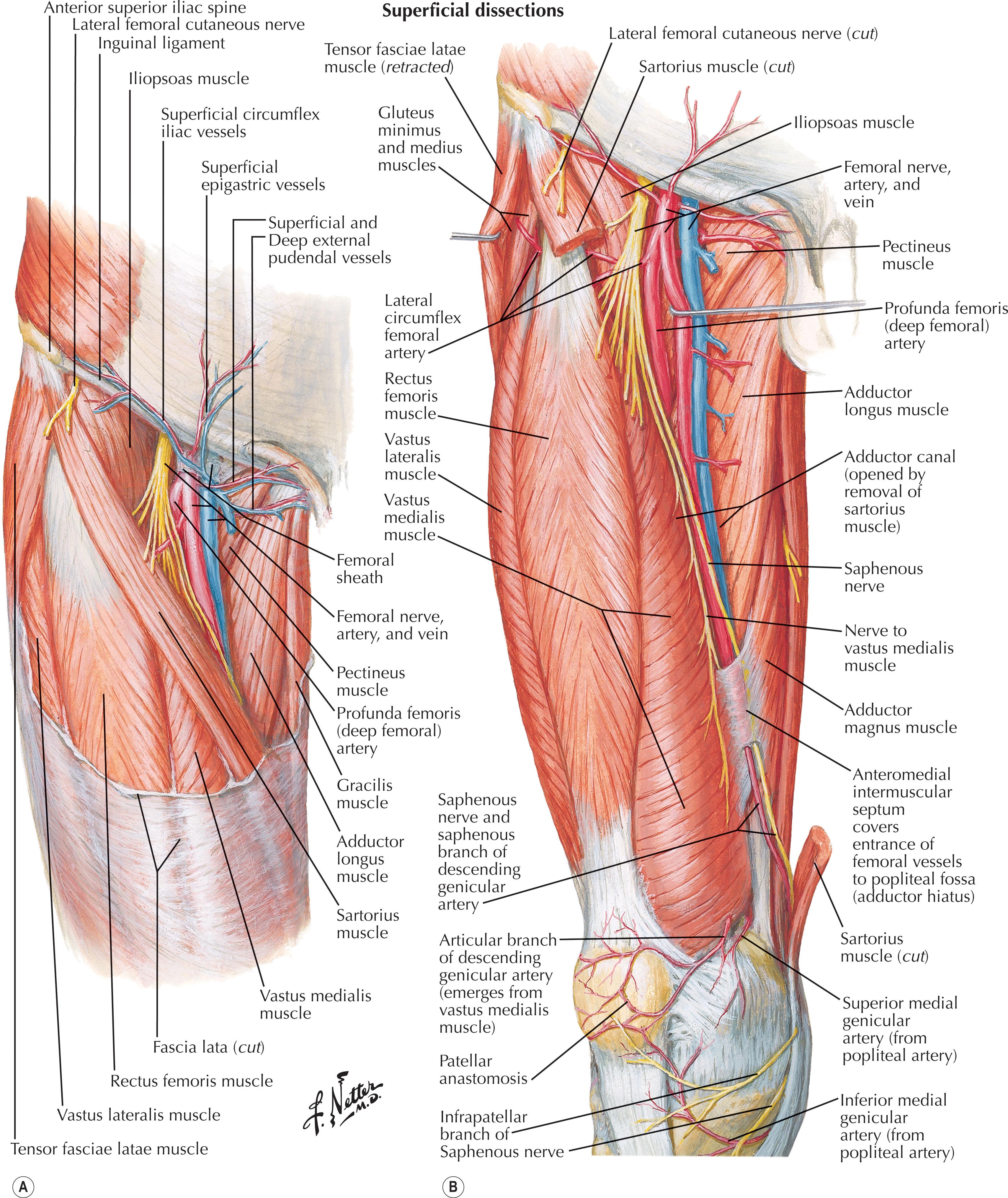
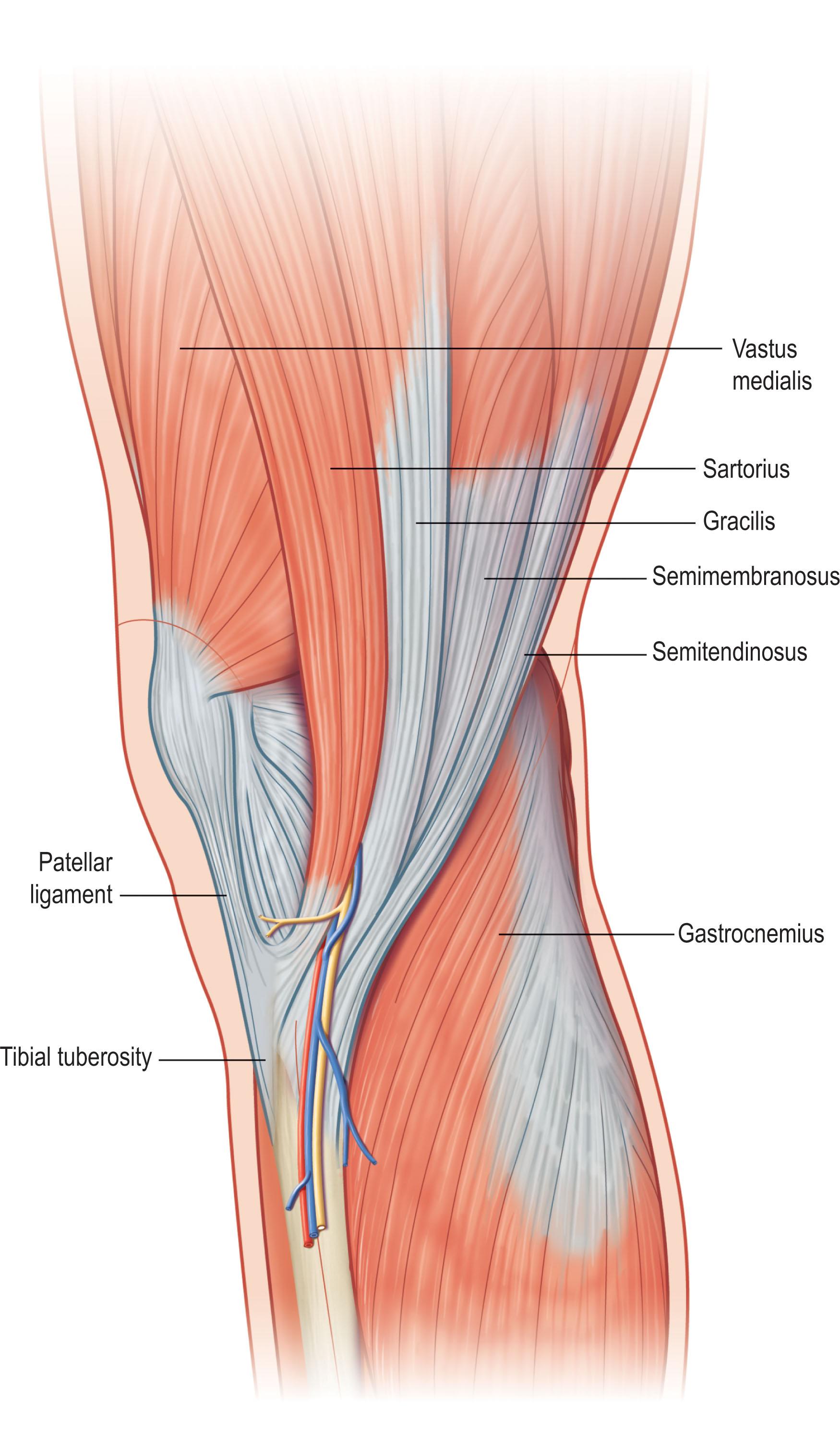
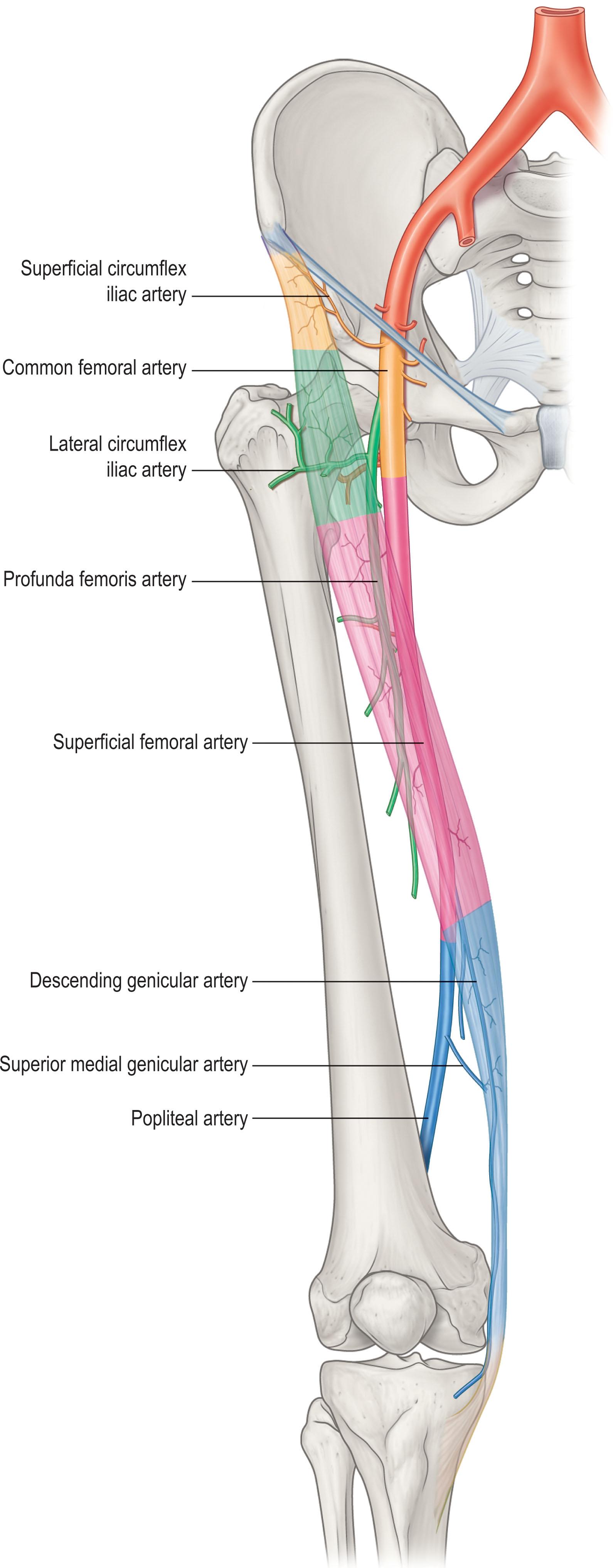
The quadriceps muscles act as a unit through the patella and the patellar tendon to extend the lower leg at the knee. Knee extension is critical in ambulation and upright posture maintenance. The redundancy in function of these four muscles ensures this ability and removal of one of the quadriceps muscles can usually be tolerated with appropriate centralization techniques of the remaining musculature and physical therapy. This recovery potential is a primary factor in the ability to use the type II rectus femoris muscle for regional and distant reconstructions. The dominant pedicle from the descending branch of the lateral circumflex artery allows for wide transposition of the rectus femoris muscle or musculocutaneous flap with minimal impact on knee function.
The posterior compartment musculature comprises the knee flexion muscles, colloquially known as the hamstrings ( Table 1.2 ). The biceps has two heads, each with a slightly different origin and action. All three of these muscles span the posterior knee, with the tendons of the semitendinosus and semimembranosus traveling medially and forming one border of the popliteal fossa and the biceps femoris tendon traveling laterally and forming the other border ( Fig. 1.12 ).
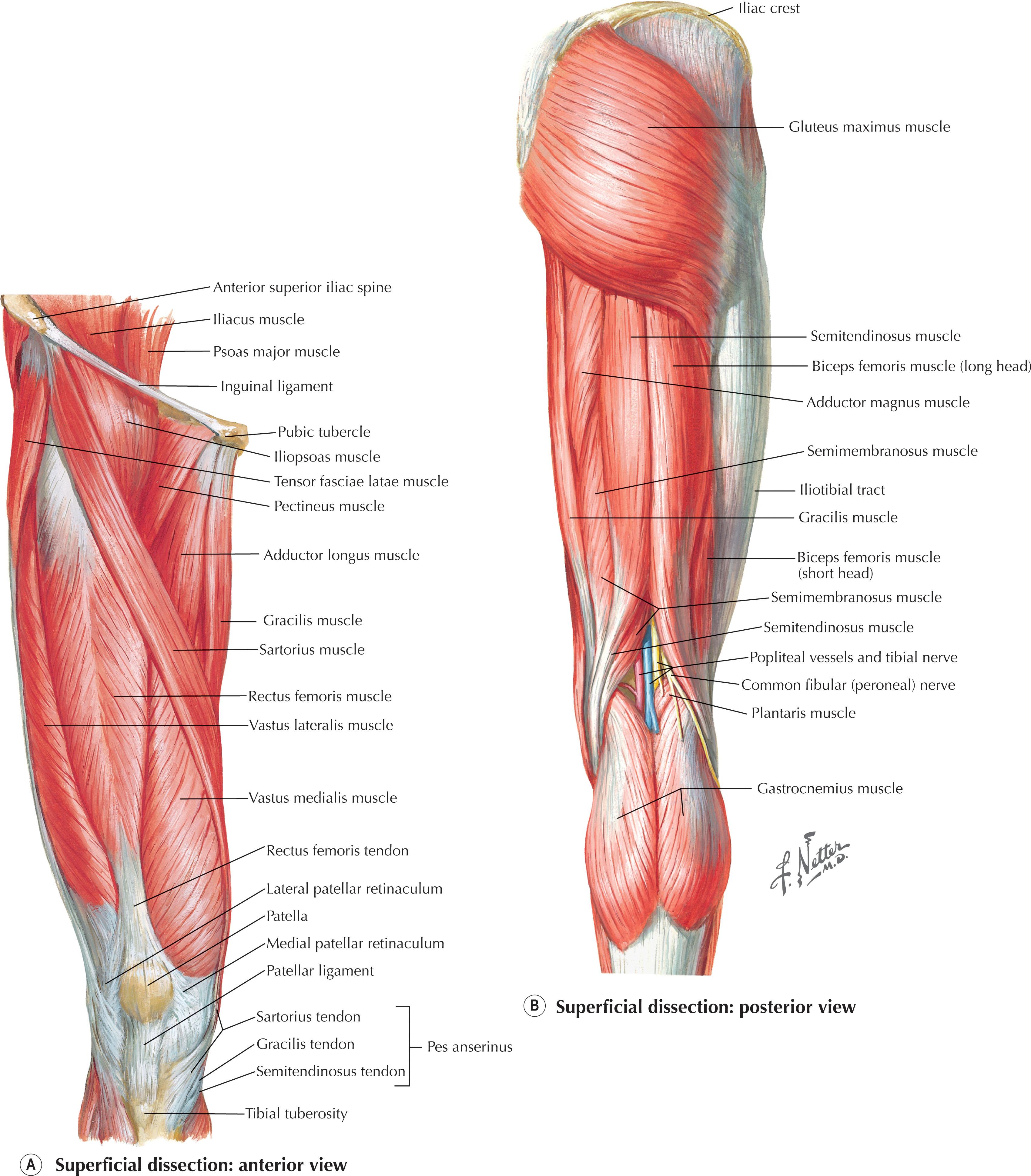
The adductor compartment contains the adductor magnus, brevis, and longus, as well as the gracilis and pectineus muscles ( Fig. 1.13 ). All five muscles cross the hip joint but only the gracilis crosses the knee. The gracilis is also the most superficial muscle of the adductor compartment. It begins from its origin on the pubic bone as a flat, broad muscle that tapers down into a narrow tendon that inserts into the pes anserinus. The gracilis is often harvested for wound coverage and can be transferred as a pedicled flap for local coverage or a free flap for distant reconstruction. It can also be harvested with its nerve supply for functional upper extremity reconstruction or facial reanimation. The gracilis has a type II vascular supply, perfused from a dominant medial circumflex femoral artery pedicle, with three to six muscular branches entering the muscle on the deep surface adjacent to a branch of the obturator nerve and each branch proceeding distally in an independent, longitudinal manner, allowing for muscle subdivision when necessary. As opposed to the gracilis, the remainder of the adductor muscles do not lend themselves easily for flap transposition due to their position and muscular structure.
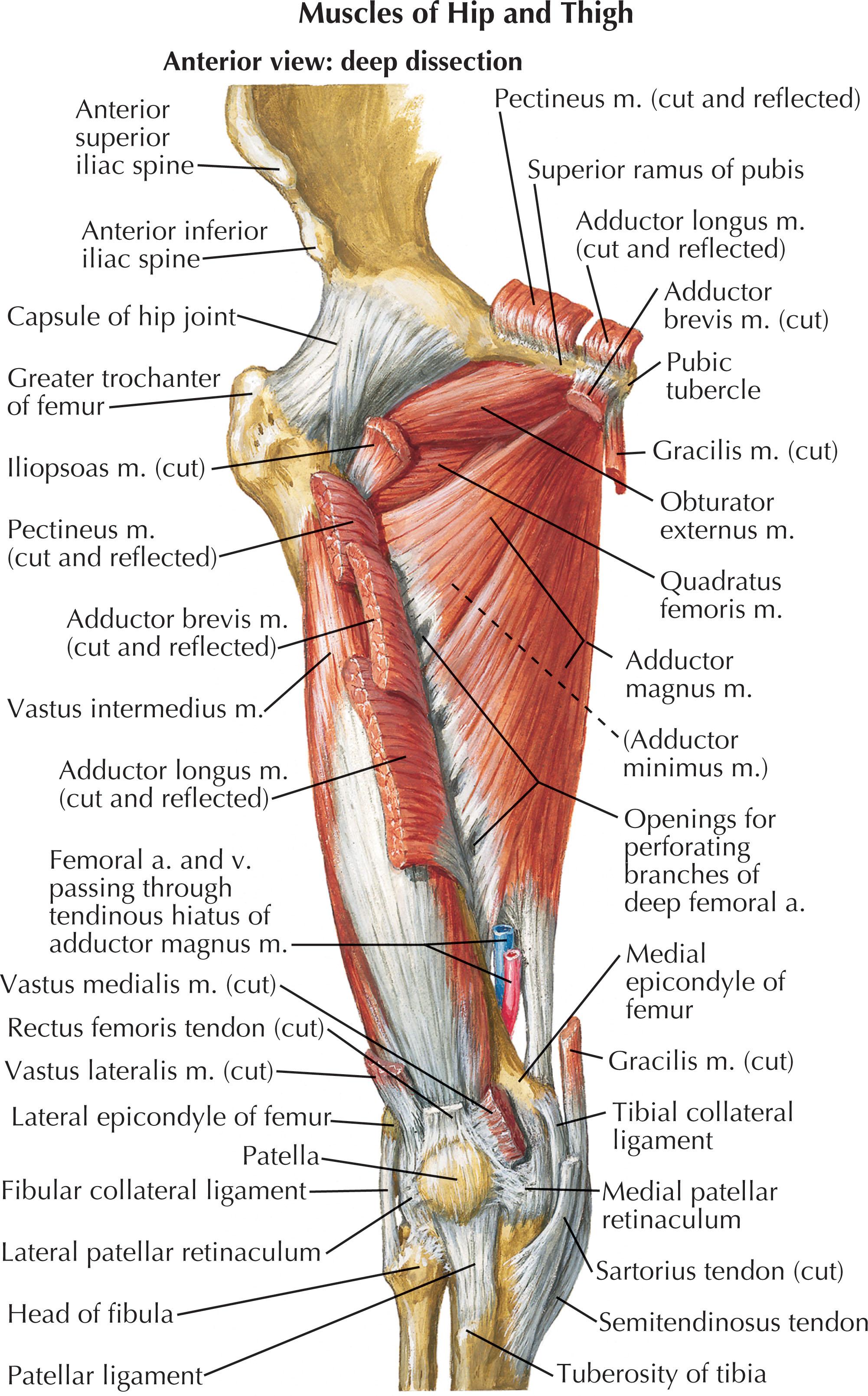
The tensor fascia latae is not classically designated in the previously described compartments but included in the discussion of the thigh because of its intimate relation to thigh musculature and utility in reconstructive surgery. The tensor fascia latae lies on the proximal lateral aspect of the thigh originating from the iliac crest. As it descends distally, it is enveloped by the two layers of the iliotibial band ( Figs. 1.7 and 1.9 ). The tensor fascia latae muscle usually ends in the proximal third of the thigh but can extend down to the lateral femoral condyle. Its blood supply is from the ascending or transverse branch of the lateral circumflex femoral arterial system. This allows the muscle and fascia to be included with other flaps based off the same system if such a composite reconstruction is required.
The primary blood supply to the lower extremity is the femoral artery ( Fig. 1.14 ). It courses with the femoral vein through the femoral sheath, a short canal composed of the continuation of the transversalis fascia anteriorly and the iliac fascia posteriorly. These fascial layers fuse with the vascular adventitia approximately 4 cm inferior to the inguinal ligament. The femoral artery crosses beneath the sartorius muscle and enters Hunter’s canal, a fibromuscular canal bounded laterally by the vastus medialis, inferiorly by the adductor longus and magnus, and anteromedially by the sartorius. The femoral artery exits Hunter’s canal through the adductor hiatus, entering the popliteal fossa, at which point it is referred to as the popliteal artery.
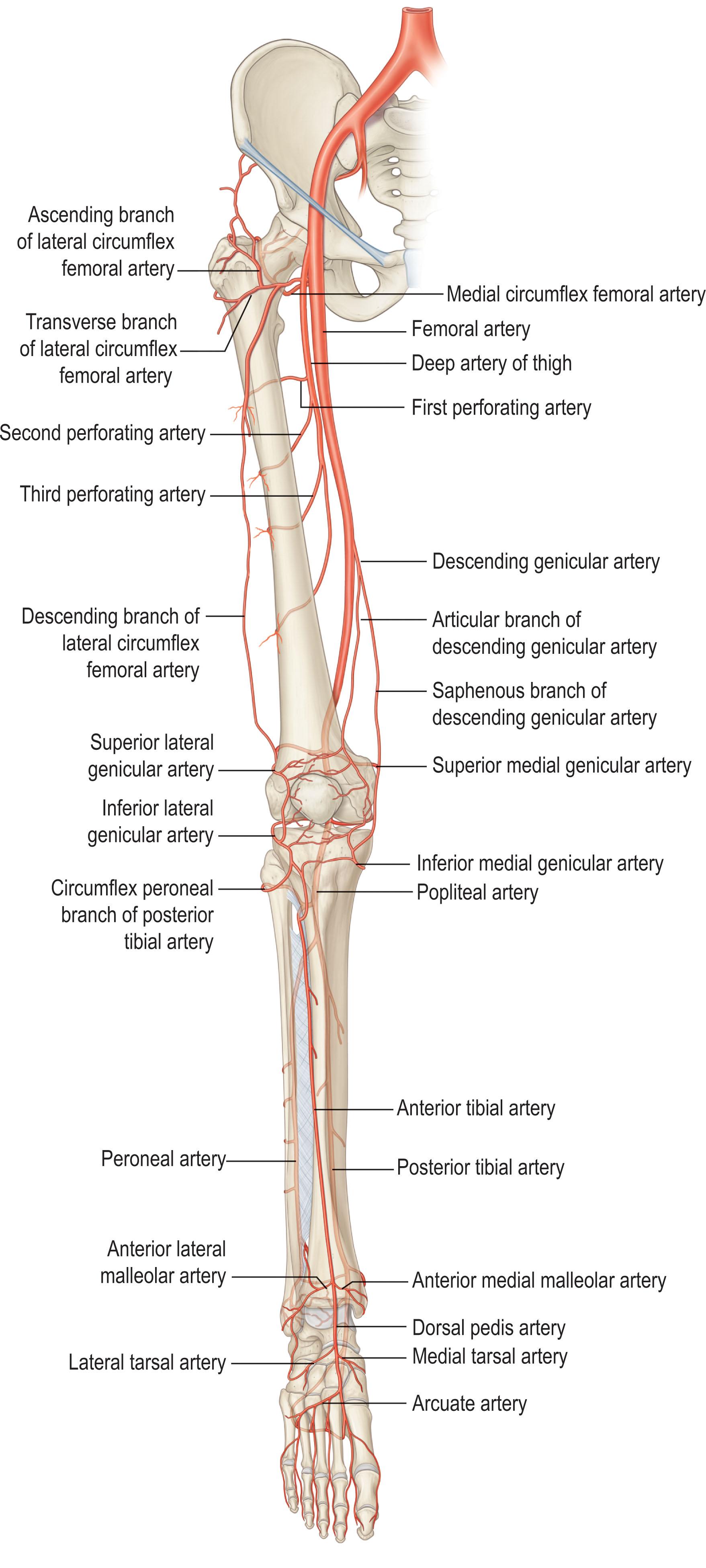
In the proximal thigh, the femoral artery bifurcates 4 cm inferior to the inguinal ligament into the profunda femoris (also called the deep femoral artery) and the superficial femoral artery (SFA). Although there is some debate over the terminology of the femoral artery’s origin and distal progression, it is usually described as follows: the external iliac artery becomes the femoral artery after it crosses the inguinal ligament, then the femoral artery branches into the profunda femoris and the SFA. The profunda femoris usually branches from the posterolateral aspect of the femoral artery then passes deep to the adductor longus muscle, between the insertions of the lateral and medial intermuscular septa, and runs posterior to the linea aspera of the femur ( Figs. 1.8 and 1.15 ).
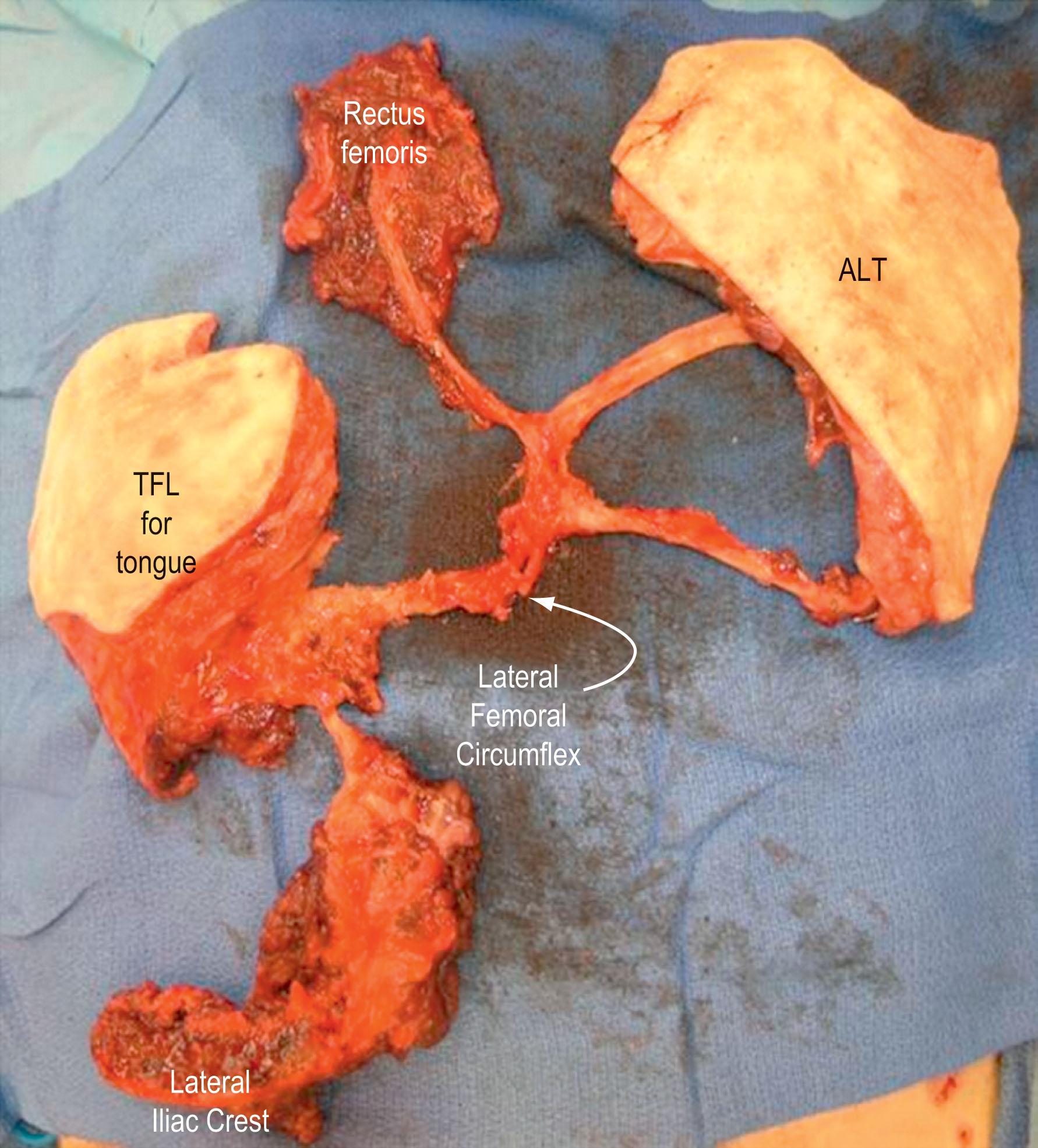
In the thigh, the profunda femoris is the predominant blood supply source. There are some important contributions to thigh musculature by the SFA (the adductors, sartorius, and the vastus medialis), but the main vascular distribution for the three thigh compartments arises from the profunda femoris. The majority of the pedicles to thigh musculature arise in the proximal two-thirds of the thigh from the six major branches of the profunda femoris: the lateral and medial circumflex arteries and four perforating arteries ( Fig. 1.16 ).
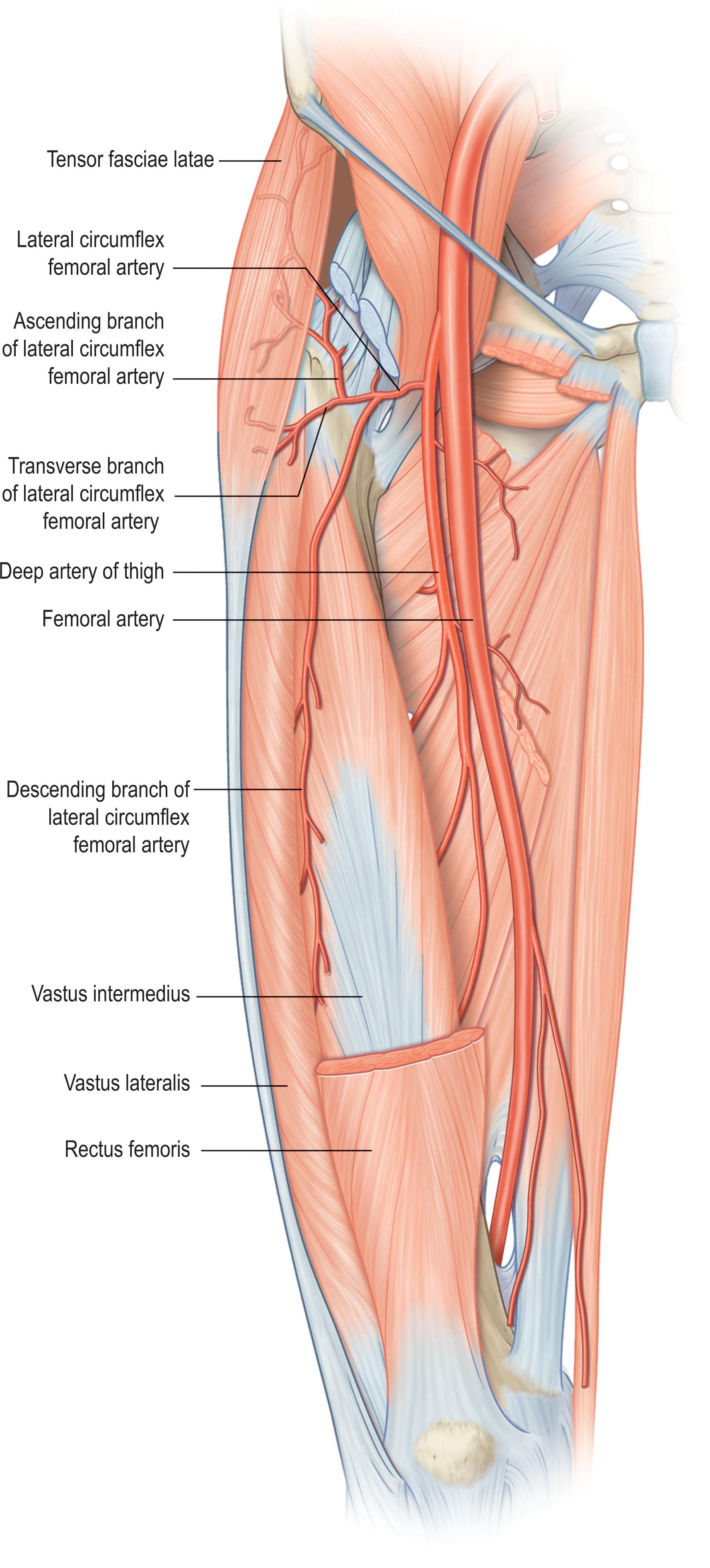
The lateral circumflex femoral arterial system is particularly relevant to the reconstructive surgeon due to the popularity of flap options that can be harvested on it. Classically, the lateral circumflex femoral artery (LCFA) is described as the second major branch off the profunda femoris, splitting into the ascending, transverse, and descending branches ( Fig. 1.17 ). The ascending branch travels along the intertrochanteric line, supplying the greater trochanter, the tensor fascia latae, anterior iliac crest, and the skin overlying the hip before connecting with the superior gluteal and deep circumflex iliac vessels. The transverse branch passes through the vastus lateralis and curls posteriorly around the femur, joining with the medial circumflex artery. The descending branch usually travels in the intermuscular septum between the vastus intermedius and the overlying rectus femoris. From these branches, cutaneous perforators either travel through the musculature (musculocutaneous perforators) or between the musculature along the intervening fibrous septa (septocutaneous perforators).
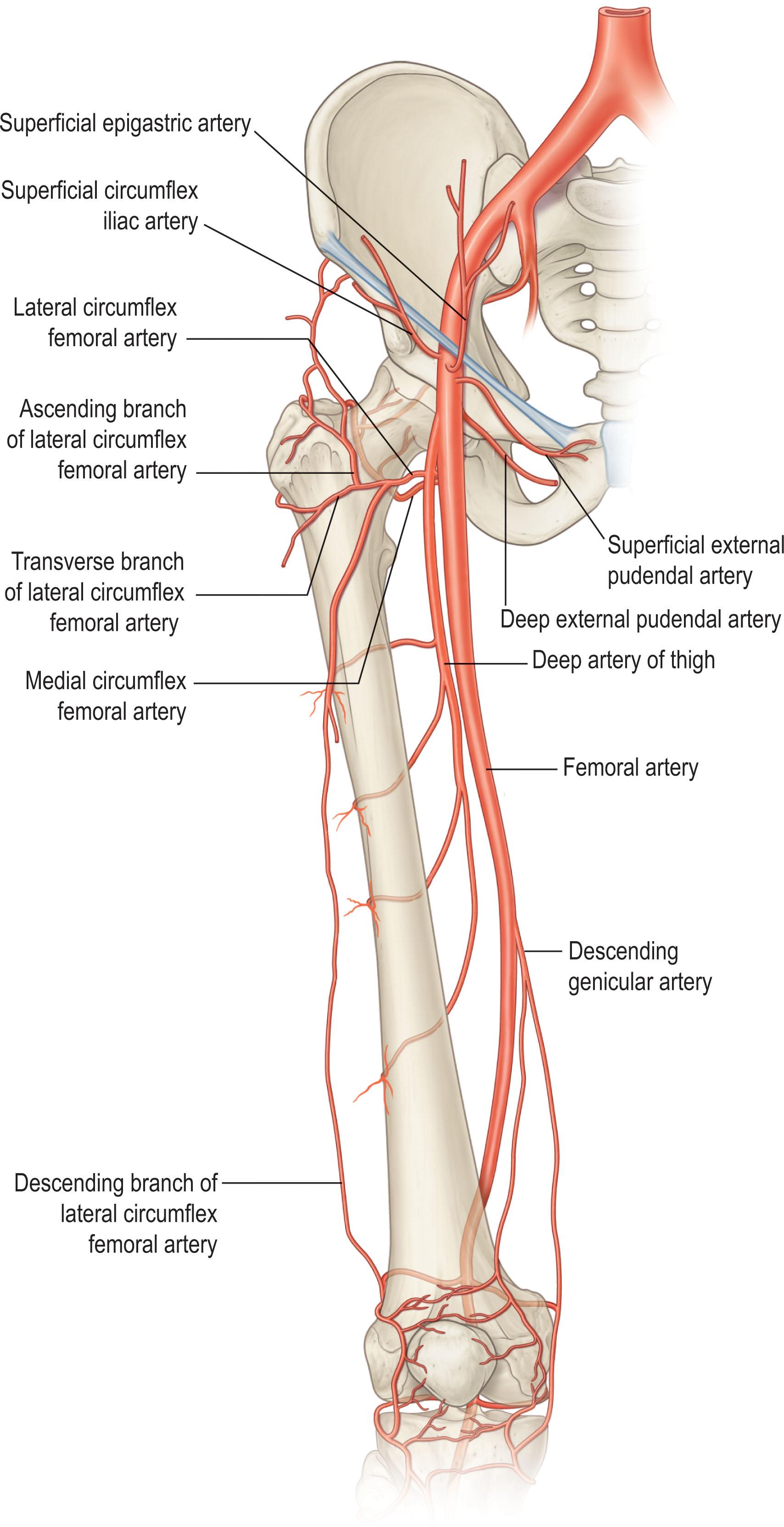
There is great variability in the LCFA system and the classical description of the location of the vessels and their courses does not always hold. In 20% of cases, the take-off of the lateral circumflex femoral artery is from a different source vessel than the profunda femoris. It can arise from the common femoral artery itself, present as a split artery traveling from the femoral artery and the profunda femoris separately, from a common origin for the profunda femoris and the medial circumflex femoral artery (MCFA), from the MCFA, or even from the external iliac artery. In spite of this multiplicity of anatomic variations, the LCFA system provides a robust interconnected blood supply to skin, muscle, fascia, and bone. This can be exploited for a plethora of flap compositions in a variety of orientations. The numerous independent branches of the LCFA system allow for construction of chimeric flaps with multiple tissue types, including anterolateral thigh skin, fascia lata, vastus lateralis, rectus femoris, tensor fascia latae, and lateral iliac crest ( Fig. 1.15 ).
The distal aspect or descending branch of the LCFA can often be utilized as a salvage recipient vessel option in lower extremity reconstruction. In major oncological resections of the proximal lower leg/knee or traumatic injuries with a large zone of injury, there may not be sufficient recipient vessels in the lower leg for free tissue transfer. In these circumstances, a primary vein graft or arteriovenous loop can be performed from the distal LCFA to perfuse the transferred flap. In our experience, the challenging aspect of this approach is not only selecting the vessel where there is sufficient caliber for arterial anastomosis, but also where the accompanying vein is not diminutive to avoid a large size mismatch. This is typically more proximal than one would initially anticipate, and thus a vein graft is almost always required. A 10–12 cm incision can be made overlying the intermuscular septum in the mid-thigh. Identification of the septum and the approach to the LCFA is similar to harvest of a vastus lateralis or anterolateral thigh free flap. Elevation and medialization of the rectus femoris is critical. We recommend identifying the LCFA proximally first and then dissecting distally as the descending branch or distal continuation can become intermuscular and less predictable more distally in the thigh. A deep Adson–Beckman retractor and/or dull fish hooks/lone star retractors facilitate exposure for anastomoses and obviate the need for retraction assistance. If necessary to avoid muscular compression on the vein graft following anastomoses in the thigh, a trough can be created on the superficial aspect of the vastus lateralis muscle.
The anterolateral thigh flap (ALT), based on the LCFA system, is one of the most popular soft-tissue flaps for microvascular tissue transfer in reconstructive surgery. There is considerable variability in the arterial anatomy of the ALT flap. Most commonly, perforators from the descending branch of the LCFA supply the ALT flap. However, in up to 44% of cases, there is an oblique branch, arising most commonly from the descending branch of the LCFA or, less frequently, from the transverse branch of the LCFA, which provides the dominant perforator supply to the ALT flap. When an oblique branch is present, in over 90% of cases it will supply an additional codominant pedicle to the rectus femoris muscle. The implication of this is that an ALT flap can be reliably harvested on either pedicle without compromising perfusion to the rectus femoris. The superior-most cutaneous perforator is reliably located approximately 17 cm inferior to the ASIS along a line from the ASIS to the lateral patella. The majority of cutaneous perforators will be found within a 3-cm radius around the midpoint of this line. Septocutaneous perforators to the ALT flap, which allow for more efficient dissection than musculocutaneous perforators, can be expected to be present in nearly 20% of cases, and are more common in the proximal thigh. A major benefit of the ALT flap is the potential for a long vascular pedicle. With a proximal harvest, the pedicle ranges from 4 to 8 cm; however, when harvested distally, the pedicle can reach 20 cm in length.
The MCFA emerges from the medial and posterior aspect of the profunda, winds around the medial side of the femur, passes between the pectineus and psoas major, and then between the obturator externus and the adductor brevis to supply the adductor compartment ( Fig. 1.17 ). As the artery passes between the quadratus femoris and the adductor magnus, it splits into descending and transverse branches. The transverse branch passes posteriorly to the femur and joins the transverse branch of the LCFA and the inferior gluteal artery, known as the cruciate connection. The descending branch of the MCFA branches into several muscular branches to supply the gracilis muscle. The MCFA system mirrors the LCFA system as a nexus of branches that supply multiple different muscles and cutaneous regions. Branches of the MCFA are typically smaller than those of the LCFA. However, patients with small or absent LCFA perforators tend to have larger branches from the MCFA, suggesting a reciprocal dominance of blood supply.
Become a Clinical Tree membership for Full access and enjoy Unlimited articles
If you are a member. Log in here